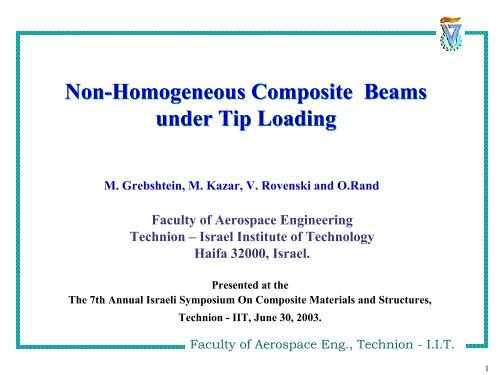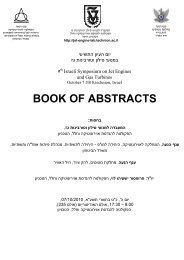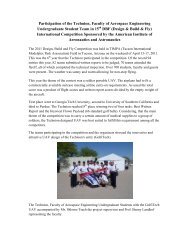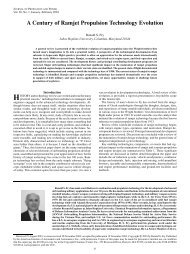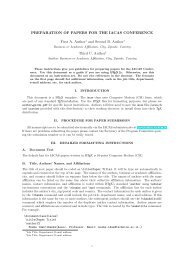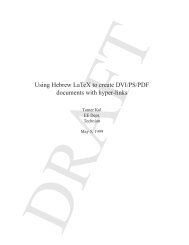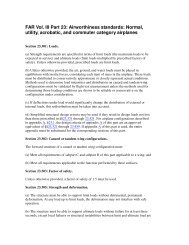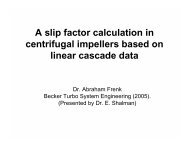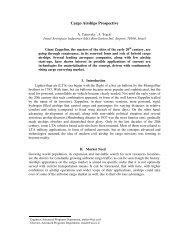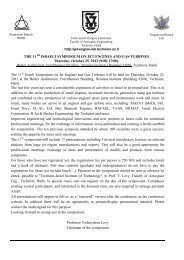Torsion (cont.) - Faculty of Aerospace Engineering
Torsion (cont.) - Faculty of Aerospace Engineering
Torsion (cont.) - Faculty of Aerospace Engineering
You also want an ePaper? Increase the reach of your titles
YUMPU automatically turns print PDFs into web optimized ePapers that Google loves.
Non-Homogeneous Composite Beams<br />
under Tip Loading<br />
M. Grebshtein, M. Kazar, V. Rovenski and O.Rand<br />
<strong>Faculty</strong> <strong>of</strong> <strong>Aerospace</strong> <strong>Engineering</strong><br />
Technion – Israel Institute <strong>of</strong> Technology<br />
Haifa 32000, Israel.<br />
Presented at the<br />
The 7th Annual Israeli Symposium On Composite Materials and Structures,<br />
Technion - IIT, June 30, 2003.<br />
<strong>Faculty</strong> <strong>of</strong> <strong>Aerospace</strong> Eng., Technion - I.I.T.<br />
1
Outline<br />
• Motivation and Background<br />
> Notation<br />
> Material properties<br />
> Non-homogeneous cross-section definition<br />
> Interlaminar conditions<br />
• The proposed analytical methodology<br />
> St. Venant’s Semi-Inverse methodology<br />
> The three auxiliary problems <strong>of</strong> plane deformation<br />
> The bending and torsion functions<br />
• Illustrative examples<br />
> <strong>Torsion</strong><br />
> Bending<br />
• Concluding remarks<br />
<strong>Faculty</strong> <strong>of</strong> <strong>Aerospace</strong> Eng., Technion - I.I.T.<br />
2
Motivation<br />
• Fiber-reinforced composite materials are extensively used in many engineering<br />
applications (civil and military aircraft, space, automotive, commercial,<br />
etc.), from replacement pieces to all-composite design.<br />
• Composite structures exhibit some pr<strong>of</strong>ound advantages:<br />
> Specific strength and stiffness<br />
> Improved fatigue characteristics<br />
> Elastic coupling (for beams: “bending-twist”, “bending-extension”<br />
and “extension-twist”).<br />
<strong>Faculty</strong> <strong>of</strong> <strong>Aerospace</strong> Eng., Technion - I.I.T.<br />
3
Existing Methods<br />
• Analytic formulations (linear theory) [Lechnitskii (50), Sokolnik<strong>of</strong>f (56),<br />
Muskhelishvili (53), Rukhadze].<br />
• Semi-analytic methods [Kosmatka (91), Kim and Dugundje (93),<br />
Rand (93,94,97), Yamane and Friedmann (93),<br />
Pai and Nyfeh (94), Robbins and Reddy (93-95),<br />
Laulusa (94), Zapfe and Lesieutre (95),<br />
Francescatti and Kaiser (96), Betti and Gjelsvik (96),<br />
Song and Librescu (97), Soldatos and Watson (97)].<br />
• High order theories [Robbins and Reddy (93-95), Suresh and Nagaraj (96),<br />
McCarthy and Chattopadhyay (96)].<br />
• Numerical (approximate) methods [Sankar (93), Floros and Smith (97),<br />
Chopra et al (95-97), Makeev and Armanios (99)].<br />
<strong>Faculty</strong> <strong>of</strong> <strong>Aerospace</strong> Eng., Technion - I.I.T.<br />
4
Notation<br />
Tip loads<br />
Surface loads<br />
Body loads<br />
“root”<br />
“outer<br />
surface”<br />
v(x,y,z)<br />
“tip”<br />
u(x,y,z)<br />
w (x,y,z)<br />
<strong>Faculty</strong> <strong>of</strong> <strong>Aerospace</strong> Eng., Technion - I.I.T.<br />
5
Material Properties<br />
Orthotropic<br />
‘x’,y’,z<br />
<strong>Faculty</strong> <strong>of</strong> <strong>Aerospace</strong> Eng., Technion - I.I.T.<br />
6
Non-Homogeneous Cross-Section<br />
Definition<br />
Generic Laminated<br />
<strong>Faculty</strong> <strong>of</strong> <strong>Aerospace</strong> Eng., Technion - I.I.T.<br />
7
The Interlaminar Conditions<br />
Stress resultants (equilibrium):<br />
Displacements (compatibility):<br />
<strong>Faculty</strong> <strong>of</strong> <strong>Aerospace</strong> Eng., Technion - I.I.T.<br />
8
The proposed analytical methodology<br />
St. Venant’s Semi-Inverse methodology (“solution hypothesis”).<br />
The three auxiliary problems <strong>of</strong> plane deformation (biharmonic BVP).<br />
The bending and torsion functions (harmonic BVP).<br />
<strong>Faculty</strong> <strong>of</strong> <strong>Aerospace</strong> Eng., Technion - I.I.T.<br />
9
Tip Axial Force Effect<br />
Homogeneous<br />
Non-Homogeneous<br />
<strong>Faculty</strong> <strong>of</strong> <strong>Aerospace</strong> Eng., Technion - I.I.T.<br />
10
Transverse Bending Force Effect<br />
bending function <strong>of</strong> the first kind<br />
<strong>Faculty</strong> <strong>of</strong> <strong>Aerospace</strong> Eng., Technion - I.I.T.<br />
11
The three auxiliary problems <strong>of</strong> plane deformation<br />
No external surface loads:<br />
Internal loads equilibrium:<br />
{<br />
{<br />
<strong>Faculty</strong> <strong>of</strong> <strong>Aerospace</strong> Eng., Technion - I.I.T.<br />
12
The three auxiliary problems <strong>of</strong> plane deformation (<strong>cont</strong>.)<br />
Prescribed deformation dis<strong>cont</strong>inuity:<br />
The first auxiliary problem:<br />
{<br />
<strong>Faculty</strong> <strong>of</strong> <strong>Aerospace</strong> Eng., Technion - I.I.T.<br />
13
The three auxiliary problems <strong>of</strong> plane deformation (<strong>cont</strong>.)<br />
Biharmonic BVP:<br />
{<br />
<strong>Faculty</strong> <strong>of</strong> <strong>Aerospace</strong> Eng., Technion - I.I.T.<br />
14
Source <strong>of</strong> the Three Auxiliary Plane-Strain Problems<br />
a) The First Auxiliary Problem:<br />
Extension by a tip force.<br />
b) The Second Auxiliary Problem:<br />
Bending about the x direction by a tip<br />
force or a tip moment.<br />
c) The Third Auxiliary Problem:<br />
Bending about the y direction by a tip<br />
force or a tip moment.<br />
<strong>Faculty</strong> <strong>of</strong> <strong>Aerospace</strong> Eng., Technion - I.I.T.<br />
15
The Bending Function <strong>of</strong> the First Kind<br />
Harmonic BVP:<br />
Field Equation:<br />
B.C.:<br />
:Continuity<br />
<strong>Faculty</strong> <strong>of</strong> <strong>Aerospace</strong> Eng., Technion - I.I.T.<br />
16
Displacement:<br />
Strain:<br />
Stress:<br />
Field Equation:<br />
Stress:<br />
<strong>Torsion</strong>al Moment Effect<br />
Displacement:<br />
<strong>Faculty</strong> <strong>of</strong> <strong>Aerospace</strong> Eng., Technion - I.I.T.<br />
17
Combining all Tip Loads Effects<br />
<strong>Faculty</strong> <strong>of</strong> <strong>Aerospace</strong> Eng., Technion - I.I.T.<br />
18
Example: <strong>Torsion</strong> <strong>of</strong> Non-Homogenous Beam<br />
<strong>Faculty</strong> <strong>of</strong> <strong>Aerospace</strong> Eng., Technion - I.I.T.<br />
19
<strong>Torsion</strong> (<strong>cont</strong>.)<br />
<strong>Torsion</strong> function ϕ<br />
<strong>Faculty</strong> <strong>of</strong> <strong>Aerospace</strong> Eng., Technion - I.I.T.<br />
20
<strong>Torsion</strong> (<strong>cont</strong>.)<br />
Stress component τ yz<br />
<strong>Faculty</strong> <strong>of</strong> <strong>Aerospace</strong> Eng., Technion - I.I.T.<br />
21
<strong>Torsion</strong> (<strong>cont</strong>.)<br />
τ<br />
Stress component xz<br />
<strong>Faculty</strong> <strong>of</strong> <strong>Aerospace</strong> Eng., Technion - I.I.T.<br />
22
Bending <strong>of</strong> Non-Homogenous Beam<br />
y<br />
x<br />
<strong>Faculty</strong> <strong>of</strong> <strong>Aerospace</strong> Eng., Technion - I.I.T.<br />
23
Bending <strong>of</strong> Non-Homogenous Beam<br />
(<strong>cont</strong>.)<br />
Solution <strong>of</strong> the third auxiliary problem<br />
<strong>Faculty</strong> <strong>of</strong> <strong>Aerospace</strong> Eng., Technion - I.I.T.<br />
y<br />
x<br />
24
Bending <strong>of</strong> Non-Homogenous Beam<br />
(<strong>cont</strong>.)<br />
Solution <strong>of</strong> the third auxiliary problem (<strong>cont</strong>.)<br />
x<br />
x<br />
y<br />
y<br />
σ xx<br />
σ yy<br />
<strong>Faculty</strong> <strong>of</strong> <strong>Aerospace</strong> Eng., Technion - I.I.T.<br />
y<br />
x<br />
25
Bending <strong>of</strong> Non-Homogenous Beam<br />
(<strong>cont</strong>.)<br />
Solution <strong>of</strong> the third auxiliary problem (<strong>cont</strong>.)<br />
x y<br />
σ zz<br />
x<br />
τ xy<br />
<strong>Faculty</strong> <strong>of</strong> <strong>Aerospace</strong> Eng., Technion - I.I.T.<br />
y<br />
y<br />
x<br />
26
Bending <strong>of</strong> Non-Homogenous Beam (<strong>cont</strong>.)<br />
y<br />
The bending function χ 1<br />
x<br />
x<br />
The bending function χ 2<br />
<strong>Faculty</strong> <strong>of</strong> <strong>Aerospace</strong> Eng., Technion - I.I.T.<br />
y<br />
27
The <strong>Torsion</strong> Function<br />
x<br />
The torsion function ϕ<br />
y<br />
<strong>Faculty</strong> <strong>of</strong> <strong>Aerospace</strong> Eng., Technion - I.I.T.<br />
28
Solution for Py<br />
x<br />
σ xx<br />
y<br />
x<br />
Py<br />
σ yy<br />
<strong>Faculty</strong> <strong>of</strong> <strong>Aerospace</strong> Eng., Technion - I.I.T.<br />
y<br />
y<br />
x<br />
29
Solution for Py (<strong>cont</strong>.)<br />
x<br />
σ zz<br />
y<br />
Py<br />
τ xy<br />
<strong>Faculty</strong> <strong>of</strong> <strong>Aerospace</strong> Eng., Technion - I.I.T.<br />
x<br />
y<br />
y<br />
x<br />
30
Solution for Py (<strong>cont</strong>.)<br />
x<br />
τ yz<br />
y<br />
x<br />
τ xz<br />
Py<br />
<strong>Faculty</strong> <strong>of</strong> <strong>Aerospace</strong> Eng., Technion - I.I.T.<br />
y<br />
y<br />
x<br />
31
Concluding Remarks<br />
• The paper presents a derivation and closed-form exact analytic<br />
solutions for the Saint-Venant's problem <strong>of</strong> beams <strong>of</strong> nonhomogenous<br />
cross-sections.<br />
• The proposed methodology is composed <strong>of</strong> six sub-solutions<br />
for the tip loads effect.<br />
• The derivation is founded on three auxiliary biharmonic BVPs<br />
and exploits Saint-Venant's semi-inverse methodology and known<br />
solutions for homogeneous beams. In addition, the derivation<br />
employs Neumann-type BVPs for the bending and the torsion<br />
functions.<br />
• Illustrative examples <strong>of</strong> solutions were carried out via polynomial<br />
expansion <strong>of</strong> the involved stress functions.<br />
<strong>Faculty</strong> <strong>of</strong> <strong>Aerospace</strong> Eng., Technion - I.I.T.<br />
32


